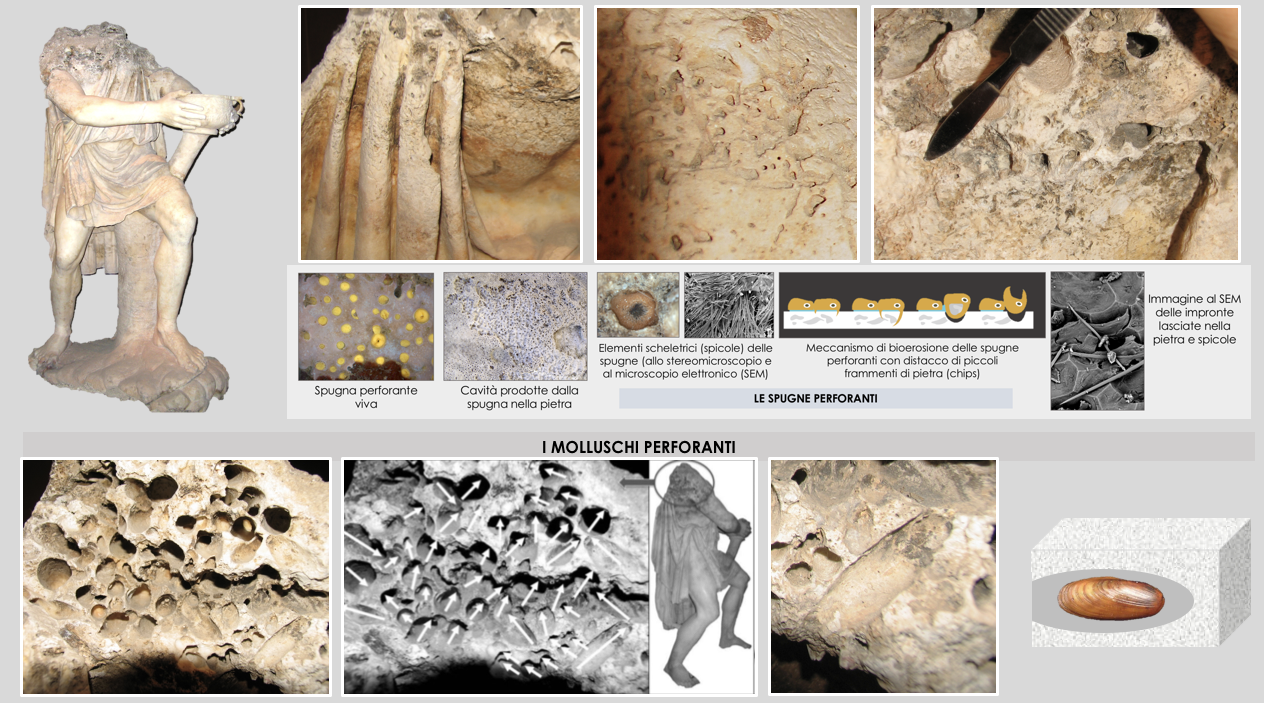The statue was found in the submerged Imperial Nymphaeum of Punta Epitaffio in January 1969, following a storm surge. Along with the statues of Polyphemus (now lost) and Ulysses’ companion with the wineskin, they were part of the decoration of the apse in the building of Baiae, characterized as a large antrum cyclopis.
The sculpture in white marble depicted the Homeric hero while offering a jug of wine to the Cyclops, according to a famous episode in the Odyssey: this scene was depicted in numerous works and the most famous one is perhaps the fronton of Ephesus, now reconstructed in the Museum of Selçuk, in Turkey.
The head of Ulysses was lost due to the action of marine organisms and may be reconstructed only on the basis of iconographic comparisons.

The statue of Ulysses during recovery operations (photo: C. Ripa)

The harnessed statue of Ulysses brought back to the surface (photo: C. Ripa)

The statue is missing a part of the shoulders and the head due to degradation caused by marine organisms that attacked the marble in the areas not covered by the sediment. In the following image, this phenomenon is represented with a reconstruction hypothesis that allows for estimating the notable loss suffered by the artefact.

The most destructive degradation process was the one caused by bivalve molluscs, which densely colonized the top section of the artefact. The following image shows numerous holes dug by the species of Lithophaga lithophaga (known as date mussel) that settled deeply in the marble following various orientations in relation to the usable space and the direction of the current. The identification of the species was done on the basis of the form of the tunnels and the discovery of numerous specimens inside the holes. The following image illustrates the position of the mollusc inside the tunnel. Such a type of attack deprived the artefact of a substantial quantity of the original stone material, leading to the complete destruction of the upper part.
In correspondence with the parts bio-eroded by molluscs and in nearby areas, the presence of perforations and cavities attributable to boring sponges (whose bio-erosive process is visible in the image below) was observed. Such a boring mechanism takes place via a chemical-mechanical action carried out by specialized cells that incorporate small fragments (known as “chips”). These are expelled in the water from the sponges’ exhalant structures.
Optical and SEM microscope observations of small fragments have highlighted that the outermost parts of the stone were attacked by microorganisms that dug a thick network of tunnels whose dimensions vary from 2 to 10 microns. The use of polyester resins allowed for obtaining faithful moulds of these galleries and to identify various groups of microorganisms (cyanobacteria, microfungi, microalgae) on the basis of the moulds’ morphology.
Such a degradation, even though not visible to the naked eye, can often favour the colonisation by micro-organisms whose work is alleviated by the lower resistance of the substrate.
Andreae, B. 1982. L’immagine di Ulisse. Mito e archeologia. Torino: Giulio Einaudi Editore, pp. 69-77
Andreae, B. 1983, Le sculture, in Zevi F., Baia. Il ninfeo imperiale sommerso di Punta Epitaffio. Banca Sannitica, pp. 50-52.
Avilia F., Caputo, P. 2015, Il ninfeo sommerso di Claudio a Baia. Napoli: Valtrend Editore.
Davidde B., Ricci S., Poggi D., Bartolini M., 2010. Marine bioerosion of stone artefacts preserved in the Museo Archeologico dei Campi Flegrei in the Castle of Baia (Naples), Archaeologia Maritima Mediterranea; 7: 75-115.
De Franciscis, A. 1969, La sorpresa sottomarina di Baia, in Il Domani d’Italia. Rivista meridionale di cultura e politica, 2, pp. 48-50.
Ricci S., Sacco Perasso C., Antonelli, F., Davidde Petriaggi B., 2015. Marine Bivalves colonizing roman artefacts recovered in the Gulf of Pozzuoli and in the Blue Grotto in Capri (Naples, Italy): boring and nestling species. International Biodeterioration & Biodegradation (98) 89 – 100.
Ricci, S., Pietrini, A. M., Bartolini, M., Sacco Perasso, C., 2013. Role of the microboring marine organisms in the deterioration of archaeological submerged lapideous artifacts (Baia, Naples, Italy). International Biodeterioration & Biodegradation 82 (2013) 199-206.
Ricci S., Davidde B., Bartolini M., Priori G. F., 2009. Bioerosion of lapideous objects found in the underwater archaeological site of Baia (Naples). Archaeologia Maritima Mediterranea, 6: 167-188.
Zevi F. 1983, Baia. Il ninfeo imperiale sommerso di Punta Epitaffio. Banca Sannitica.
Zevi F. (cur.) 2009, Museo archeologico dei Campi Flegrei. Castello di Baia. Napoli: Electa Napoli.



